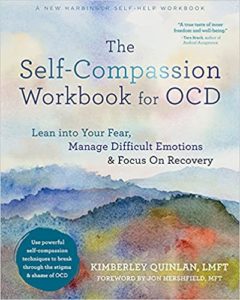Kimberley Quinlan, LMFT, has graciously given me permission to publish an excerpt from one of my favorite parts of her amazing new book, The Self-Compassion Workbook for OCD: Lean into Your Fear, Manage Difficult Emotions & Focus On Recovery.
When I first read the clipping up/clipping down metaphor below, it deeply resonated with me. As I share in Is Fred in the Refrigerator? Taming OCD and Reclaiming My Life, during my decades of untreated OCD, I spent most of my time trying to “clip up” to make amends for being a “bad” person. I knew I was bad because my mind kept telling me I’d done bad things and that my violent, scary, uncontrollable thoughts were bad. As a result, I was somehow worth less than other people. If I could just clip up repeatedly, maybe I’d even the score. But of course, I could never clip up enough, no matter what I did.
As Kimberley so eloquently explains below, none of us needs to clip up, as we’re all equally worthy regardless of what OCD says. Throwing away the clip chart has been foundational for my OCD recovery, and I hope it will be for yours as well.
Reclaiming your life from OCD requires doing some 180s. Learning to face—not avoid—your fears. Treating yourself nicely rather than beating yourself up. And you are holding the only book that teaches you how to do both at the same time! This is the guide to learning how to do self-compassionate ERP for OCD, written by one of the most talented and compassionate ERP therapists I know.
Equality (from The Self-Compassion Workbook for OCD)
Believe it or not, self-compassion is not just about meeting pain with kindness. Self-compassion is a human rights issue and an issue of social equality. You and I—and every other human being—are equal in our worth, and we all are deserving of compassion. The topic of equality is going to be the cornerstone of your self-compassion practice. Let’s explore this concept with a story.
 When my son was in kindergarten, he and all of his wide-eyed, curious, and vibrant classmates were each given a tall and narrow clip-chart. In the center, a clothespin was attached to the edge of the chart. Above the peg was a series of sections that led to the top section, which said, “Great Job! You made it! [smiley face]” Below the peg was another series of sections leading to the bottom, which said, “Teacher calls your parents. [frowning face]” If you behaved well, your teacher would incrementally “clip up” your clothespin to the next section up. If you “clipped down,” your clothespin would move down one section. If you behaved well all day and incrementally moved your peg to the “You made it!” section, you got to have special playtime at the end of the day. Sadly, we all know what happens to the kids whose pin was moved to the bottom section [frowning face].
When my son was in kindergarten, he and all of his wide-eyed, curious, and vibrant classmates were each given a tall and narrow clip-chart. In the center, a clothespin was attached to the edge of the chart. Above the peg was a series of sections that led to the top section, which said, “Great Job! You made it! [smiley face]” Below the peg was another series of sections leading to the bottom, which said, “Teacher calls your parents. [frowning face]” If you behaved well, your teacher would incrementally “clip up” your clothespin to the next section up. If you “clipped down,” your clothespin would move down one section. If you behaved well all day and incrementally moved your peg to the “You made it!” section, you got to have special playtime at the end of the day. Sadly, we all know what happens to the kids whose pin was moved to the bottom section [frowning face].
The spaces between the [smiley face], the clothespin, and the [frowning face] showed different emojis so that the children knew they were either on their way to success or on the way to having an awkward talking to by their parents. My son would often come home proud of himself for being awarded special playtime and would sometimes come home to report that he had come one step away from the “call your mommy” section.
So, you might be wondering what these charts have to do with you and equality? Simply put, when it comes to your worth as a human being, there is no such thing as “clipping up” or “clipping down.” Equality means everyone is worthy of love, compassion and respect, no matter what. Equality means that everyone lives at the top, right up there in the “You made it!” section, every single day. Equality means that you are worthy, no matter what thoughts you have, what your mental health status is, no matter what mental or medical diagnosis you have, and no matter your race, sexuality, income, physical ability, social media following, your productivity, or what size body you live in.
While the clip-chart system works really well at managing behavior in a classroom of kindergarteners, it should not be implemented into adulthood as a way of calculating your deservedness for love, compassion, and respect. Unfortunately, our society has collectively adopted this metaphorical clip-chart system and used it to ruin our sense-of-self. Most likely, from a very young age, you also started calculating your worth based on external factors. Using this messy mathematical equation, you lost sight that you are equally deserving of love, compassion, and respect as any other human. Instead, we rank ourselves and each other, telling ourselves that some people rank higher and therefore deserve more than we do and that some rank lower than us, giving us permission to use their situation to make us feel better about ourselves.
The metaphorical clip-chart system mistakenly declares that if you behave in a certain way, not only did you “do good things,” but also that you are “good.” If you perform poorly or fail to meet the standards our society demand of us, this means not only that you did a “bad” thing but also that you are “bad.” If you have good thoughts, you are good, and if you have bad thoughts, you are bad. This faulty calculation is where shame is born and thrives, perpetuating a false narrative about who you are, your worth as a human being, and what you deserve.
 Equality means that all humans (yes, including you) deserve an abundance of love, kindness, compassion, safety, and respect. I insist that right now you throw out the clip-chart and start treating yourself as an equal. Stop clipping yourself down when you have an intrusive thought or engage in a compulsion. Stop gathering mental lists of all of your “bad” behaviors. Remember, there is no clip-chart. Everyone is at the top, and everyone is an equal. Until you throw it out, you will continue to engage in harmful comparison, self-punishment, self-blame, self-criticism, and other hurtful behaviors. Everyone, including you, deserves to be treated with the same degree of respect, compassion, and care. Your worth and deservedness of self-compassion has nothing to do with your mental health status, mental health diagnosis, the thoughts you think, the images you imagine, the sensations you sense, the emotions you feel, the urges you experience, and the compulsions you engage in.
Equality means that all humans (yes, including you) deserve an abundance of love, kindness, compassion, safety, and respect. I insist that right now you throw out the clip-chart and start treating yourself as an equal. Stop clipping yourself down when you have an intrusive thought or engage in a compulsion. Stop gathering mental lists of all of your “bad” behaviors. Remember, there is no clip-chart. Everyone is at the top, and everyone is an equal. Until you throw it out, you will continue to engage in harmful comparison, self-punishment, self-blame, self-criticism, and other hurtful behaviors. Everyone, including you, deserves to be treated with the same degree of respect, compassion, and care. Your worth and deservedness of self-compassion has nothing to do with your mental health status, mental health diagnosis, the thoughts you think, the images you imagine, the sensations you sense, the emotions you feel, the urges you experience, and the compulsions you engage in.
Except from pages 28-29. (c) Kimberley Quinlan. All Rights Reserved. Reprinted with permission from the author.
Girl holding heart © Can Stock Photo / Rohappy
Learn more about taming OCD
Sign up for my Shoulders Back! newsletter to receive OCD-taming tips & resources, including notifications of new blog posts, delivered every month to your inbox.
My blogs are not a replacement for therapy, and I encourage all readers who have obsessive compulsive disorder to find a competent ERP therapist. See the IOCDF treatment provider database for a provider near you. And never give up hope, because you can tame OCD and reclaim your life!







Leave A Comment